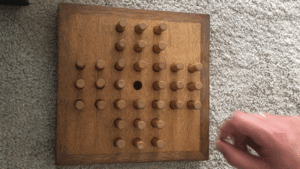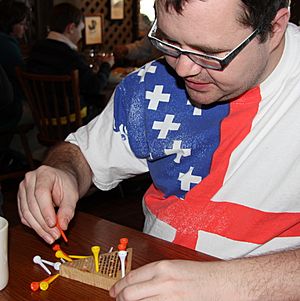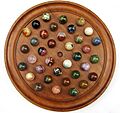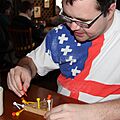Peg solitaire facts for kids
Peg solitaire (also called Solo Noble) is a fun board game for just one player. It uses pegs (or marbles) on a board with holes. In the United Kingdom, it's simply called Solitaire. Card games there are known as Patience. In India, it's often called Brainvita.
The game first appeared in the court of King Louis XIV in France around 1697. An old picture from 1697 shows the Princess of Soubise playing it. The first time the game was written about was in a French magazine called Mercure galant in August 1687. It described the board, rules, and some puzzles.
The main goal of the game is to start with almost all holes filled with pegs. Only the center hole is empty. You need to make special moves to remove pegs until only one peg is left. That last peg should end up in the center hole.
Contents
Board Types
There are two main types of boards: the English board and the European board. They look a bit different. In the diagrams below, a "·" means a peg is in that hole, and "o" means the hole is empty.
| English Board | European Board |
|---|---|
|
· · · · · · · · · · · · · · · · o · · · · · · · · · · · · · · · · |
· · · · · · · · · · · · · · · · · · o · · · · · · · · · · · · · · · · · · |
How to Play
To make a move, you must jump one peg over an adjacent peg. The jumped peg must land in an empty hole two spaces away. After the jump, you remove the peg that was jumped over. You can only jump straight, not diagonally.
Here's how moves look in diagrams:
·means a peg is in a hole.*means this is the peg you are going to move.omeans an empty hole.- A blue
¤shows where the peg started. - A red
oshows the peg that was jumped and removed. - A red
*shows where the peg landed.
Let's see some examples of valid jumps:
* · o → ¤ o * Jump to the right
o · * → * o ¤ Jump to the left
* ¤ · → o Jump down o *
o * · → o Jump up * ¤
On an English board, here are the first three moves of a possible game:
· · · · · · · · · · · · · * · · ¤ · · o · · * · · · · · · · · · · · o · · · · · · * o ¤ · · · · · * o · · · · o · · · · · · * · · · · · · · · · · · · · · · · · · · · · · · · · · · · · · · · · · · · · · · · · · · · · · · · · · · · · · · · · · · · · · · · · · · · ·
Strategy and Solutions
There are many ways to solve the standard Peg Solitaire puzzle. People use different ways to write down solutions. One way is to give letters to each hole on the board:
English European a b c a b c d e f y d e f z g h i j k l m g h i j k l m n o p x P O N n o p x P O N M L K J I H G M L K J I H G F E D Z F E D Y C B A C B A
On the European board, if you start with an empty hole in one spot, you might be able to finish with a single peg in a mirrored spot. On the English board, if you start with an empty hole, the final peg can often end up in the same spot.
It's interesting that the standard European board (starting with the center hole empty) cannot be solved if you only jump straight. This is because of a math idea about how the pegs move across different sections of the board.
Using a Catalyst Peg
One helpful trick is to use a "catalyst" peg. This peg helps clear out a group of three pegs. The catalyst peg jumps out, then jumps back in, removing other pegs along the way.
Here's how a catalyst peg (the *) works:
* · o ¤ o * o * · * o ¤ · → · → o → o · · ¤ o
This trick can be used to clear a line of 3 pegs, a 2x3 block of pegs, or even an L-shaped group of 6 pegs.
English Game Solutions
The shortest way to solve the standard English game takes 18 moves. Each "move" can include multiple jumps by the same peg.
| Shortest solution to English peg solitaire |
|---|
|
e-x l-j c-k · · · · · · · · · · · ¤ · * · · ¤ · · o · · o o · · · · · · · · · · o · · · · · · * o ¤ · · · · · * o · · · · o · · · · · · * · · · · · · · · · · · · · · · · · · · · · · · · · · · · · · · · · · · · · · · · · · · · · · · · · · · · · · · · · · · · · · · · · · · · · P-f D-P G-I J-H · · o · · o · · o · · o · o * · o · · o · · o · · · · · o o · · · · · o o · · · · · o o · · · · · o o · · · · · ¤ · · · · · · * · · · · · · · · · · · · · · · · · · · · · · · · · · · o · · · · · · * o ¤ · · · ¤ o * o · · · · · ¤ · · o · · o · · · · · · · · · · · · m-G-I i-k g-i L-J-H-l-j-h · · o · · o · · o · · o · o · · o · · o · · o · · · · · o o ¤ · · ¤ o * o o ¤ o * o · o o o * o o o o o · · · · · · o · · · · · · o · · · · · · o · · · · · o o · · · o * o o · · · o · o o · · · o · o o · ¤ o o o o o · · o · · o · · o · · o · · · · · · · · · · · · C-K p-F A-C-K M-g-i · · o · · o · · o · · o · o · · o · · o · · o · o · o o o o o o · o o o o o o · o o o o o o o * o o o o · · · · · o o · · ¤ · · o o · · o · · o o o · o · · o o · o * o o o o · o o o o o o · o * o o o o ¤ o · o o o o o · o * · o o · o o · o ¤ · · o · · o o ¤ o o o a-c-k-I d-p-F-D-P-p o-x ¤ o o o o o o o o · o o ¤ o o o o o o o · o o o o o o o o o o o o o o o o o o o · o · o o o o · * o o o o o ¤ o * o o o o o · o * o o o o o o o o o o o o o o o o o · o o o o o o o o o o o o o o o o |
This 18-move solution was discovered in 1912 by Ernest Bergholt. Later, in 1964, John Beasley proved that it was indeed the shortest possible solution.
You can also find this solution and learn a special way to remember it on this page.
Computer Analysis
Computers have been used to study Peg Solitaire. They can figure out all the possible moves and solutions. For the standard English board, the only places you can end up with a single peg are the center or the middle of one of the edges.
Computers have shown that there are millions of different board positions you can reach while playing. However, this is only a small part of all the possible ways pegs could be arranged on the board. Modern computers can easily check all possible game positions to find solutions.
European Game Solutions
Even though the standard European board is harder, there are some starting positions where you can solve it. For example, if you start with an empty hole in certain spots, you can find a solution.
Other Board Shapes
[[Image:Peg Solitaire game board shapes.svg|frame|none|Peg solitaire game board shapes:
(1) French (European) style, 37 holes;
(3) Asymmetrical 3-3-2-2;
Peg solitaire can be played on many different board shapes. The English and European boards are the most common. Another popular one is the triangular board. On this board, you can jump in three directions. As long as the board is big enough and has the right pattern, it can usually be solved.
A common triangular board has five pegs on each side. If you start with an empty hole in a corner, you can solve it in ten moves. If you start with an empty hole in the middle of a side, you can solve it in nine moves.
| Shortest solution to triangular variant |
|---|
|
* = peg to move next; ¤ = hole created by move; o = jumped peg removed; * = hole filled by jumping; · · · * ¤ · · · · · · · * o ¤ · · · · · · * · · ¤ · · * o · · · · · · · · · · · · · · o · · * * · * * · o · · ¤ o * * · o * o ¤ · o · * o · o · · o · o o o o o * * * * ¤ ¤ o o o o o o o o * * o o o o o * o o ¤ ¤ · · ¤ o o o o o o * * o o · o o o o o o * * o · o ¤ ¤ o · o o o o * o o o o ¤ o o * o o |
Video Game
On June 26, 1992, a video game based on peg solitaire was released for the Game Boy. It was simply called "Solitaire" and was made by Hect. In North America, another company called DTMC released the game as "Lazlos' Leap".
Images for kids
-
A man playing triangular peg solitaire at a Cracker Barrel restaurant.
See also
 In Spanish: Senku para niños
In Spanish: Senku para niños
- You can play many versions of Peg Solitaire, including English, European, Triangular, and more, at pegsolitaire.org.










